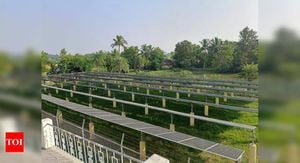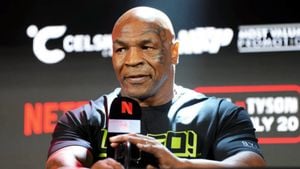The idea of rural counties wanting to split from their larger, often urbanized neighbors is gaining traction, particularly evident from movements like those seen recently in Illinois and California. While historically these kinds of secession efforts have been observed, the current wave appears stoked by political and cultural frustrations rather than just geographical divides.
Take, for example, the situation in Illinois. Here, residents of rural counties, feeling neglected and overshadowed by the political dominance of major cities, are contemplating breaking away to form their own smaller, independent entities. Their motivation is partially based on their belief of being marginalized by urban policies they feel don’t represent their interests. The new local political dynamics, fueled by increasingly polarized national politics, have galvanized these sentiments. There’s worry among these groups about agricultural regulations, crime rates, and taxation policies shaped by urban-centered legislations.
Similarly, California has its own brewing secession deliberations. The rural, often more conservative portions of the state are clashing with the liberal governance emanated from coastal urban areas. There’s even talk about creating new states, such as ‘State of Jefferson’, which embodies the aspiration of these rural populations to gain more control over their governance, without the influence from the rapid urban developments and legislative policies coming from the state capital, Sacramento.
Both movements are reflective of larger trends across the U.S., where divisions between urban and rural areas are becoming increasingly pronounced. These are not just matters of distance; they are symbolic of deep-seated frustrations with how policies are made. The rural populations often feel disillusioned, as they regularly voice concerns over crime legislation and environmental policies passed by representatives who don’t understand local needs.
Politically, the situation is fascinating. Many proponents of these movements are not newcomers to the political arena. County board meetings are packed with passionate arguments, some reminiscent of secession debates from the Civil War era, but today’s constituents are armed with modern technology and social media to amplify their voices.
Proponents argue they are merely seeking local governance, where decisions can be made closer to home, reflecting their unique values and needs. Critics, on the other hand, worry such efforts may deepen societal divides, making governance more difficult and fracturing communities even more. Former state legislators have chimed in, asserting these efforts could lead to significant governmental disruptions, posing challenges when it came to taxation, law enforcement, and emergency services.
Interestingly, this discontent is not exclusive to one side of the political spectrum. Both predominately conservative and some progressive factions within these rural areas express valid grievances about feeling ignored and out of touch with the central governing bodies. This points to potentially innovative paths of regionalism, where localities might take governance back from centralized urban authorities. The draw of local independence can’t be underestimated, especially when residents argue they know their communities’ needs best.
Each of these movements carries differing nuances influenced by local histories, demographics, and the socio-economic environment. The discussions have often focused on how best to manage resources and address educational needs without the perceived bureaucratic red tape from more populated regions. There’s been historical precedence for decentralized governance, fostering more community involvement. The concept of state rights has been debated extensively; many individuals advocate for the model under which states dictate local policies rather than enforce top-down mandates from urban-heavy legislatures.
It is also significant to note how the media has played its role. Reports often highlight the frustrations of rural citizens but sometimes fail to capture the systemic issues at play, such as economic disparities and the concentration of resources. It often appears as though the media narrates these stories with preconceived notions about rural-versus-urban dynamics, missing the opportunity to address common ground issues. These discussions are multifaceted, often touched with emotional undertones.
Whether one supports these secession movements or views them skeptically, they certainly represent changing attitudes among rural populations. The sentiment is clear: individuals crave representation and recognition of their unique challenges. These issues, which have been simmering for years, seem to have reached the boiling point.
Several grassroots organizations have begun forming to facilitate these discussions, relying heavily on social media to organize meetings, share opinions, and educate constituents about the potential ramifications of secession. This has created communities united not just against the perceived threats posed by urban governments, but also for opportunities to reshape their futures.
There are significant legal and political hurdles to secession, requiring extensive knowledge of state constitutions and legislative processes. For example, the new counties would need permission from the state legislature and possibly the U.S. Congress. Hence, most movements remain largely aspirational. Still, they highlight intense emotions fueling these local initiatives.
Better funding for rural services, educational equity, more flexible regulatory frameworks, and enhanced infrastructure are common demands among those advocating for change. The belief is to create local governance structures where voices are proportionately represented, and policies reflect the citizens’ unique needs.
The outcomes of these discussions may not only impact the involved counties but also set precedents for rural communities across the nation, possibly sparking similar movements elsewhere. Surprisingly, the attention on rural socio-political dynamics has stirred interests among urban residents too, as they feel the effects of these movements reaching beyond geographical boundaries.
The question remains of how state political apparatuses and urban centers will respond to this increasing discontent. Will state legislators push for policies aimed at bridging gaps and addressing rural concerns? Or will they dig their heels in, prompting more rural constituents to seek drastic solutions?
Local conversations will undoubtedly continue as rural counties navigate their aspirations for greater autonomy against the backdrop of state governance. At some point, these deliberations may reach statewide or even national political discourse, affecting policies and shaping the future of political representation across various demographics.
These rural independence movements are more than just political statements; they symbolize the growing chasm between different American lifestyles and ideologies. Perhaps rather than trying to divide, the focus should shift toward bridging gaps, promoting empathy, and fostering interconnectedness between urban and rural constituents, which could lead to holistic advancements for all populations.



